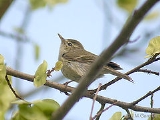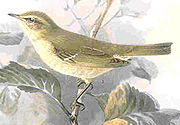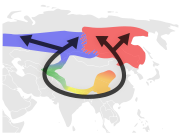
Greenish Warbler
Encyclopedia
The Greenish Warbler and Green Warbler (Phylloscopus trochiloides) are widespread leaf-warblers throughout their breeding range in northeastern Europe
and temperate
to subtropical continental Asia
. This warbler
is strongly migratory
and winters in India
. It is not uncommon as a spring or early autumn vagrant in Western Europe
and is annually seen in Great Britain
. In Central Europe
large numbers of vagrant birds are encountered in some years; some of these may stay to breed, as a handful of pairs does each year in Germany
.
Like all leaf-warblers, it was formerly placed in the "Old World warbler
" assemblage, but now belongs to the new leaf-warbler family
Phylloscopidae
.
 This is a typical leaf-warbler in appearance, grayish-green above and off-white below. The single wing bar found in the southern and western populations distinguishes them from most similar species
This is a typical leaf-warbler in appearance, grayish-green above and off-white below. The single wing bar found in the southern and western populations distinguishes them from most similar species
(except Arctic Warbler
P. borealis). It is slightly smaller than that species and has a thinner bill, without a dark tip to the lower mandible
. A latitude
-based analysis of wintering birds indicated that more northerly P. trochiloides are smaller, i.e. this species does not seem to follow Bergmann's rule
.
Its song is a high jerky trill, in some populations containing a sequence of down- and more rarely up slurred notes.
It breeds in lowland deciduous or mixed forest; non-breeding birds in the warmer parts of its range may move to montane
habitat
in summer. Individuals from southeast of the Himalayas are for example quite often seen in Bhutan
during the hot months, typically in humid Bhutan Fir (Abies densa) forest up to about 3,800 meters ASL
or more, but they do not breed there and return again to the adjacent subtropical lowlands in winter.
The nest is on the ground in low shrub. Like its relatives, this small passerine
is insectivorous.
 It has a number of subspecies
It has a number of subspecies
, of which P. t . viridianus is the most familiar in Europe. As it seems, it is a ring species
, with populations diverging east- and westwards of the Tibetan Plateau
, later meeting on the northern side. Their relationships are therefore fairly confusing:
The groups' origin lies probably in the Himalayan region, where trochiloides is found. This taxon
is close to the parapatric obscuratus, and to plumbeitarsus which is geographically separated from obscuratus; they all can (and in the case of the former two do naturally) hybridize. P. t. plumbeitarsus is often split as distinct species
, as it does not hybridize with viridianus in the narrow zone in the western Sayan Mountains
where their ranges overlap.
But phylogenetically, the western taxa are even more distinct. However, there is some gene flow
between trochiloides and viridianus also, with their hybrids being especially common in Baltistan
; they were once considered another subspecies ludlowi. nitidus is a mountain isolate that diverged from ancestral viridianus.
Song structure differs mainly between trochiloides and plumbeitarsus. The former has a fairly uniform, long, and warbling song. Around the Himalayas, song structure is similar, but songs are generally shorter. plumbeitarsus, on the other hand, has a long song that can be clearly divided into a warbling part, followed by series of up- and downslurred notes. The songs of obscuratus, and, interestingly, "ludlowi", are short, but contain the downslur elements too; in the latter, they uniquely appear at the start of the song.
Europe
Europe is, by convention, one of the world's seven continents. Comprising the westernmost peninsula of Eurasia, Europe is generally 'divided' from Asia to its east by the watershed divides of the Ural and Caucasus Mountains, the Ural River, the Caspian and Black Seas, and the waterways connecting...
and temperate
Temperate
In geography, temperate or tepid latitudes of the globe lie between the tropics and the polar circles. The changes in these regions between summer and winter are generally relatively moderate, rather than extreme hot or cold...
to subtropical continental Asia
Asia
Asia is the world's largest and most populous continent, located primarily in the eastern and northern hemispheres. It covers 8.7% of the Earth's total surface area and with approximately 3.879 billion people, it hosts 60% of the world's current human population...
. This warbler
Warbler
There are a number of Passeriformes called "warblers". They are not particularly closely related, but share some characteristics, such as being fairly small, vocal and insectivorous....
is strongly migratory
Bird migration
Bird migration is the regular seasonal journey undertaken by many species of birds. Bird movements include those made in response to changes in food availability, habitat or weather. Sometimes, journeys are not termed "true migration" because they are irregular or in only one direction...
and winters in India
India
India , officially the Republic of India , is a country in South Asia. It is the seventh-largest country by geographical area, the second-most populous country with over 1.2 billion people, and the most populous democracy in the world...
. It is not uncommon as a spring or early autumn vagrant in Western Europe
Western Europe
Western Europe is a loose term for the collection of countries in the western most region of the European continents, though this definition is context-dependent and carries cultural and political connotations. One definition describes Western Europe as a geographic entity—the region lying in the...
and is annually seen in Great Britain
Great Britain
Great Britain or Britain is an island situated to the northwest of Continental Europe. It is the ninth largest island in the world, and the largest European island, as well as the largest of the British Isles...
. In Central Europe
Central Europe
Central Europe or alternatively Middle Europe is a region of the European continent lying between the variously defined areas of Eastern and Western Europe...
large numbers of vagrant birds are encountered in some years; some of these may stay to breed, as a handful of pairs does each year in Germany
Germany
Germany , officially the Federal Republic of Germany , is a federal parliamentary republic in Europe. The country consists of 16 states while the capital and largest city is Berlin. Germany covers an area of 357,021 km2 and has a largely temperate seasonal climate...
.
Like all leaf-warblers, it was formerly placed in the "Old World warbler
Old World warbler
The "Old World Warblers" is the name used to describe a large group of birds formerly grouped together in the bird family Sylviidae. The family held over 400 species in over 70 genera, and were the source of much taxonomic confusion. Two families were split out initially, the cisticolas into...
" assemblage, but now belongs to the new leaf-warbler family
Family (biology)
In biological classification, family is* a taxonomic rank. Other well-known ranks are life, domain, kingdom, phylum, class, order, genus, and species, with family fitting between order and genus. As for the other well-known ranks, there is the option of an immediately lower rank, indicated by the...
Phylloscopidae
Phylloscopidae
Phylloscopidae is a newly described family of small insectivorous birds formerly placed in the Old World warbler family. Its members occur in Eurasia, ranging into Wallacea and Africa...
.
Description and ecology

Species
In biology, a species is one of the basic units of biological classification and a taxonomic rank. A species is often defined as a group of organisms capable of interbreeding and producing fertile offspring. While in many cases this definition is adequate, more precise or differing measures are...
(except Arctic Warbler
Arctic Warbler
The Arctic Warbler, Phylloscopus borealis, is a widespread leaf warbler in birch or mixed birch forest near water throughout its breeding range in Fennoscandia and northern Asia. It has established a foothold in North America, breeding in Alaska. This warbler is strongly migratory; the entire...
P. borealis). It is slightly smaller than that species and has a thinner bill, without a dark tip to the lower mandible
Mandible
The mandible pronunciation or inferior maxillary bone forms the lower jaw and holds the lower teeth in place...
. A latitude
Latitude
In geography, the latitude of a location on the Earth is the angular distance of that location south or north of the Equator. The latitude is an angle, and is usually measured in degrees . The equator has a latitude of 0°, the North pole has a latitude of 90° north , and the South pole has a...
-based analysis of wintering birds indicated that more northerly P. trochiloides are smaller, i.e. this species does not seem to follow Bergmann's rule
Bergmann's Rule
Bergmann's rule is an ecogeographic principle that states that within a broadly distributed genus, species of larger size are found in colder environments, and species of smaller size are found in warmer regions. Although originally formulated in terms of species within a genus, it has often been...
.
Its song is a high jerky trill, in some populations containing a sequence of down- and more rarely up slurred notes.
It breeds in lowland deciduous or mixed forest; non-breeding birds in the warmer parts of its range may move to montane
Montane
In biogeography, montane is the highland area located below the subalpine zone. Montane regions generally have cooler temperatures and often have higher rainfall than the adjacent lowland regions, and are frequently home to distinct communities of plants and animals.The term "montane" means "of the...
habitat
Habitat
* Habitat , a place where a species lives and grows*Human habitat, a place where humans live, work or play** Space habitat, a space station intended as a permanent settlement...
in summer. Individuals from southeast of the Himalayas are for example quite often seen in Bhutan
Bhutan
Bhutan , officially the Kingdom of Bhutan, is a landlocked state in South Asia, located at the eastern end of the Himalayas and bordered to the south, east and west by the Republic of India and to the north by the People's Republic of China...
during the hot months, typically in humid Bhutan Fir (Abies densa) forest up to about 3,800 meters ASL
Above mean sea level
The term above mean sea level refers to the elevation or altitude of any object, relative to the average sea level datum. AMSL is used extensively in radio by engineers to determine the coverage area a station will be able to reach...
or more, but they do not breed there and return again to the adjacent subtropical lowlands in winter.
The nest is on the ground in low shrub. Like its relatives, this small passerine
Passerine
A passerine is a bird of the order Passeriformes, which includes more than half of all bird species. Sometimes known as perching birds or, less accurately, as songbirds, the passerines form one of the most diverse terrestrial vertebrate orders: with over 5,000 identified species, it has roughly...
is insectivorous.
Subspecies and evolution

Subspecies
Subspecies in biological classification, is either a taxonomic rank subordinate to species, ora taxonomic unit in that rank . A subspecies cannot be recognized in isolation: a species will either be recognized as having no subspecies at all or two or more, never just one...
, of which P. t . viridianus is the most familiar in Europe. As it seems, it is a ring species
Ring species
In biology, a ring species is a connected series of neighboring populations, each of which can interbreed with closely sited related populations, but for which there exist at least two "end" populations in the series, which are too distantly related to interbreed, though there is a potential gene...
, with populations diverging east- and westwards of the Tibetan Plateau
Tibetan Plateau
The Tibetan Plateau , also known as the Qinghai–Tibetan Plateau is a vast, elevated plateau in Central Asia covering most of the Tibet Autonomous Region and Qinghai, in addition to smaller portions of western Sichuan, southwestern Gansu, and northern Yunnan in Western China and Ladakh in...
, later meeting on the northern side. Their relationships are therefore fairly confusing:
- Eastern group: Greenish Warblers
- Phylloscopus trochiloides trochiloides: Greenish Warbler
- Southern rim of the Himalaya eastwards from NepalNepalNepal , officially the Federal Democratic Republic of Nepal, is a landlocked sovereign state located in South Asia. It is located in the Himalayas and bordered to the north by the People's Republic of China, and to the south, east, and west by the Republic of India...
into W ChinaChinaChinese civilization may refer to:* China for more general discussion of the country.* Chinese culture* Greater China, the transnational community of ethnic Chinese.* History of China* Sinosphere, the area historically affected by Chinese culture...
. - Dusky greyish green above, often traces of second wing bar.
- Southern rim of the Himalaya eastwards from Nepal
- Phylloscopus trochiloides obscuratus: Dull-green Warbler
- Intermediate between trochiloides and plumbeitarsus.
- GansuGansu' is a province located in the northwest of the People's Republic of China.It lies between the Tibetan and Huangtu plateaus, and borders Mongolia, Inner Mongolia, and Ningxia to the north, Xinjiang and Qinghai to the west, Sichuan to the south, and Shaanxi to the east...
and surroundings, China.
- Phylloscopus trochiloides plumbeitarsus: Two-barred Warbler
- Breeds Eastern SiberiaSiberiaSiberia is an extensive region constituting almost all of Northern Asia. Comprising the central and eastern portion of the Russian Federation, it was part of the Soviet Union from its beginning, as its predecessor states, the Tsardom of Russia and the Russian Empire, conquered it during the 16th...
n taigaTaigaTaiga , also known as the boreal forest, is a biome characterized by coniferous forests.Taiga is the world's largest terrestrial biome. In North America it covers most of inland Canada and Alaska as well as parts of the extreme northern continental United States and is known as the Northwoods...
. - SuperciliumSuperciliumThe supercilium is a plumage feature found on the heads of some bird species. It is a stripe which runs from the base of the bird's beak above its eye, finishing somewhere towards the rear of the bird's head. Also known as an "eyebrow", it is distinct from the eyestripe, which is a line which runs...
more yellow; upperparts more vivid green. 2 well-marked wing bars.
- Breeds Eastern Siberia
- Phylloscopus trochiloides trochiloides: Greenish Warbler
- Western group: Green Warblers
- Phylloscopus trochiloides viridanus: Western Greenish Warbler
- Breeds Western Siberia to north-east EuropeEuropeEurope is, by convention, one of the world's seven continents. Comprising the westernmost peninsula of Eurasia, Europe is generally 'divided' from Asia to its east by the watershed divides of the Ural and Caucasus Mountains, the Ural River, the Caspian and Black Seas, and the waterways connecting...
; at east of range south to NW India. - Dull green above, with yellowish supercilium, throat, breast and faint wing bar.
- Breeds Western Siberia to north-east Europe
- Phylloscopus trochiloides nitidus: Green Warbler or Bright-green Warbler
- CaucasusCaucasusThe Caucasus, also Caucas or Caucasia , is a geopolitical region at the border of Europe and Asia, and situated between the Black and the Caspian sea...
region. - Brighter; underside much more yellow. One strong and one faint wing bar, especially in young birds.
- Caucasus
- Phylloscopus trochiloides viridanus: Western Greenish Warbler
The groups' origin lies probably in the Himalayan region, where trochiloides is found. This taxon
Taxon
|thumb|270px|[[African elephants]] form a widely-accepted taxon, the [[genus]] LoxodontaA taxon is a group of organisms, which a taxonomist adjudges to be a unit. Usually a taxon is given a name and a rank, although neither is a requirement...
is close to the parapatric obscuratus, and to plumbeitarsus which is geographically separated from obscuratus; they all can (and in the case of the former two do naturally) hybridize. P. t. plumbeitarsus is often split as distinct species
Species
In biology, a species is one of the basic units of biological classification and a taxonomic rank. A species is often defined as a group of organisms capable of interbreeding and producing fertile offspring. While in many cases this definition is adequate, more precise or differing measures are...
, as it does not hybridize with viridianus in the narrow zone in the western Sayan Mountains
Sayan Mountains
The Sayan Mountains are a mountain range between northwestern Mongolia and southern Siberia, Russia.The Eastern Sayan extends from the Yenisei River at 92° E to the southwest end of Lake Baikal at 106° E...
where their ranges overlap.
But phylogenetically, the western taxa are even more distinct. However, there is some gene flow
Gene flow
In population genetics, gene flow is the transfer of alleles of genes from one population to another.Migration into or out of a population may be responsible for a marked change in allele frequencies...
between trochiloides and viridianus also, with their hybrids being especially common in Baltistan
Baltistan
Baltistan , also known as بلتیول བལིུལ་ in the Balti language, is a region in northern Pakistan which forms Gilgit-Baltistan, bordering the Xinjiang Autonomous Region of China. In addition, a part of Baltistan also falls into Jammu and Kashmir of India. It is situated in the Karakoram mountains...
; they were once considered another subspecies ludlowi. nitidus is a mountain isolate that diverged from ancestral viridianus.
Song structure differs mainly between trochiloides and plumbeitarsus. The former has a fairly uniform, long, and warbling song. Around the Himalayas, song structure is similar, but songs are generally shorter. plumbeitarsus, on the other hand, has a long song that can be clearly divided into a warbling part, followed by series of up- and downslurred notes. The songs of obscuratus, and, interestingly, "ludlowi", are short, but contain the downslur elements too; in the latter, they uniquely appear at the start of the song.

